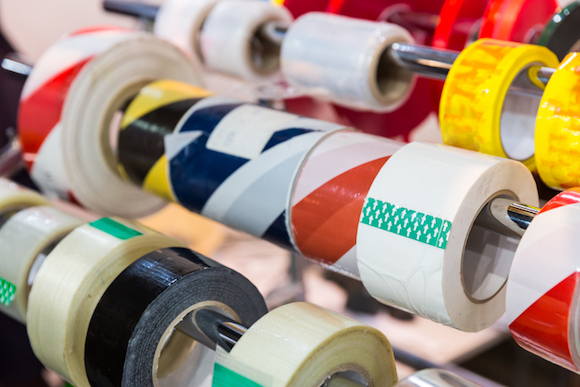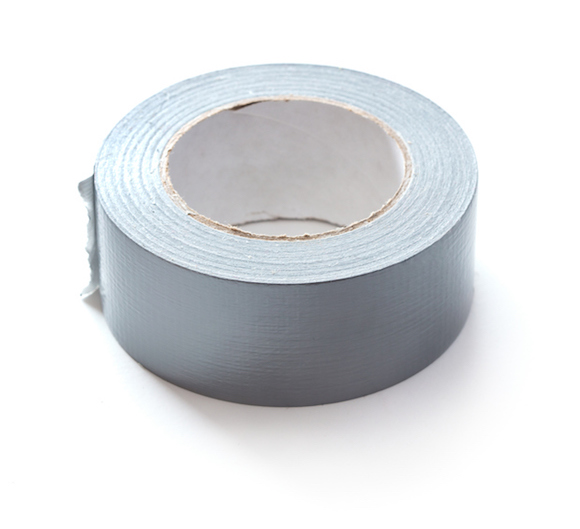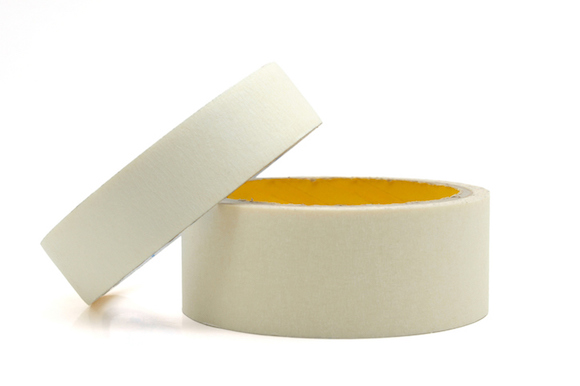As important as strong boxes and packing materials are to any move, choosing the wrong kind of tape for your move can be a disaster. Tape failure during transit, storage or packing can result in intense frustration, expensive breakage, lost time and money, compromised storage, and even physical harm should a box or plastic bin suddenly spill open at the worst moment.
If it’s your first move, your instinct may be to drop by your local superstore, snag a couple rolls of whatever you can find that has a serrated “gun” cutter attached and call it good. In which case, you just made the classic newbie mistake, according to Everett Morizen, commercial relocation specialist with Blocker Transfer & Storage of St. Petersburg, FL.
“Buy your tape from a moving company or a storage facility like U-Haul or PODs,” he advises. “That way, you know you’re getting a good-quality, industrial-strength product.”
Think all tape is created equal?
Think again. The best tape for moving boxes use for sealing moving boxes will be labeled for “moving” or “storage”, and feature an acrylic adhesive.
Shipping Tape vs Packing Tape
They might look similar, but shipping tape and packing tape are not the same.
- Shipping tape is lighter and thinner, as it is only meant to tape up boxes that aren’t too heavy. Shipping tape can withstand plenty of handling, but may not stand up to the rigors of long-term storage.
- Packing tape, also sold as storage tape, is designed to survive up to 10 years of heat, cold and humidity without cracking or losing its stick. Packing tape is the best tape for packing boxes.
To make things more confusing, both shipping tape or packing tape can be referred to as packaging tape. Just remember that not all packaging tape is the same, and to look for one that is specifically labelled for moving or storage boxes.
Ehrich Braunschweig, senior product development specialist for 3M-Scotch brands, explains that the first step for choosing the right tape for your situation is to determine if you are packing boxes for short-term moving and shipping or for long-term storage.
The Best Tape For Moving Boxes
When it comes to packing boxes for a move across town, or across the country, you want a tape that is strong, sticky, and reliable. Same goes for placing your boxes in storage for months or years.
We recommend Scotch Tough Grip Moving Packaging Tape for all of your moving and short-term storage needs:
This clear packaging tape secures up to 80 pounds of weight per box, and provides a strong grip on all types of cardboard surfaces.
Best Tape For Storage Boxes
If you are packing boxes for long-term storage, we’d recommend Scotch Long Lasting Storage Packaging Tape. It costs more per roll, but it is designed to keep your boxes sealed for years on end through extreme temperature swings.
Choosing the Right Packaging Tape For Moving and Storage
For newbies, it’s easy to confuse lighter-duty moving/shipping tape with heavier-duty storage tape because the difference between them is unseen.
That difference?
Shipping tape uses what’s called a hotmelt adhesive, which is designed to keep packages secure through the multiple touch points and rough handling that come with shipping and moving them, while storage tape employs a heavier acrylic adhesive that’s designed to withstand heat and cold for up to a decade.
You may not see the difference but you can often hear it, as shipping tape tends to crackle loudly when dispensed, while acrylic storage tape tends toward a smooth, quiet release from the roll.
“The more aggressive hot-melt chemistries in our Scotch Shipping and Moving tapes have real high strength and last for one to two years,” Braunschweig explains. “If you’re going to be storing something in the basement or storage unit and you want that tape to last for a long, long time, we recommend using our Scotch Moving & Storage Acrylic Tape.”
Learning more about your tape options, experimenting with different types at home before you move, and reading online reviews are great ways to dial in your product choice. The search for the ideal moving tape boils down to three factors:
Adhesion
Adhesion describes how sticky the tape is. The stickier the better for moving boxes, which carry heavy loads and keep items safe in storage for years to come.
- How well does the tape stick to the materials you need to secure?
- Is it easily repositioned?
- Will it hold up to the temperature and humidity extremes in storage?
- Does it have a “release coating” on the tape back to prevent the tape-end from annoyingly re-bonding with the roll.
Strength
The millimeter (or “mil’) thickness of tape and the composition of its stickiness and backing material will determine how much box weight it will support.Tensile strength measures how much weight the tape can handle before breaking away.
- Look for quality packaging tape to have a tensile strength of 20 pounds and up.
- The most common packaging tapes range between 1.9 mil for the thinner tapes, up to 3.1 mil for heavy duty packaging tapes.
- If you have heavy boxes, you probably want to use a thicker tape; lighter, you might want to use thinner tape.
- Thicker tapes are moderately priced (under $4) for a 38-yard roll of 1.88-inch moving tape, while thinner tapes tend to be less expensive (under $3) for a 2-mil, 55-yard roll.
- Major brands in addition to Scotch include Duck, Tape King and U-Haul.
Ease of use
You don’t want to have to fight your tape or waste valuable packing time trying to keep it from splitting or re-bonding with the roll. Look for a clear packing tape that can be used with a handheld tape dispenser. Using a dispenser will save you valuable time and effort packing your boxes.
To speed packing, have an extra roll and tape gun for your co-packer, as sharing can be time-consuming.
[well type=””]Search for storage units near you
[/well]
Other Types of Tape and How to Use Them
Here’s a rundown of nine other tape types that work – and don’t work – for moving and storage:
Filament or strapping tape
The fiberglass strands in filament tape provide added support for boxes and bundles that stand to be seriously jostled in transit or exposed to heat and cold in storage. Filament tape comes in a variety of grades as determined by the weight they’ll hold, ranging from 100 pounds for general-purpose use to 380 pounds for heavier must-hold situations. It’s also available in a bi-directional pattern where the fiberglass strands crisscross.
“We sell both versions,” Braunschweig says. “It’s very good for box sealing and shipping and has tons of muscle. You can even pull your car with it!”
- Size: A 60-yard roll of 2″ wide filament tape will assemble 10-15 boxes.
- Major brands: Duck, Scotch, Universal.
- Cost: $5 to $15 a roll
Gummed paper tape
Unlike pressure-sensitive paper or poly tape, water-activated gummed paper tape, which you typically wet with a dispenser or sponge, creates a strong, permanent bond that can’t be removed without visibly scarring the cardboard container. Gummed paper tape is so strong that it strengthens the box, making it an ideal choice for heavy containers and long-term storage. Because one layer suffices, you use less tape. It’s a great choice for cartons that will be stored in extremes or heat, cold and/or humidity. It is also available with crisscrossed filament reinforcement for extra strength.
The obvious downside? It’s old-school.You have to sit there and wet it and everything else in order to use it.
- Size: a 125-yard roll of 2.75-to-3-inch-wide gummed paper tape will seal 60-80 boxes.
- Cost: $10 to $60 a roll
- Brands: Duck, Patco, Uline.
Duct tape
Duct tape’s ingenious combination of a sticks-to-everything rubber adhesive with a durable waterproof backing you can tear with your bare hands has earned it a reputation as the versatile tape for all seasons. That said, duct tape falls short for packing and moving purposes because it doesn’t adhere particularly well to cardboard, its sticky adhesive can be messy to unpack in heat, and it leaves a residue if you remove it, should you plan to keep your boxes.
- Size: a 45-yard standard roll of 1.88-inch-wide duct tape will seal 6-8 boxes.
- Cost: $5 to $10 a roll.
- Major brands: 3M, Duck, Uline.
Brown paper packaging tape
The familiar self-sticking brown paper packaging tape has one advantage over its competition: it tears by hand. Unfortunately, the cost of that convenience is, paper tape doesn’t present much of an obstacle to the blunt trauma that typically accompanies a move, nor is it waterproof. Paper packaging tape is best used for light boxes (under 30 pounds) and quick moves; not optimal for long-term storage.
- Size: a standard 2-inch-wide, 55-yard roll will seal 6-10 boxes.
- Cost: Under $3 a roll.
- Major brands: Scotch, U-Haul.
Masking tape
It’s not hard to understand the popularity of this thin, light-beige workhorse: it takes to pen and ink like paper, stands up reasonably well to water, adheres great, peels easily and tears effortlessly. True to its name, it is unparalleled at masking off straight lines when painting. But due to its composition and peel-ability, masking tape doesn’t excel at sealing much of anything.
Use it for labeling contents rather than secure them. It can also come in handy for quickly bundling loose items inside of a box, such as kitchen utensils.
- Cost: A standard 1-inch wide by 60-yard roll is inexpensive at under $3.
- Major brands: Duck, FrogTape, Scotch.
Labeled tape
If it’s your first move, rest assured: you will want to know from which room the contents of each box hailed; otherwise, you risk the backbreaking task of having to move it twice (or more). Labeled tape, such as SmartMove Tape, removes the guess work by incorporating room labels into color-specific poly packaging tape so you can label and seal your boxes in one gun-stroke. That way, you’ll know each box’s destination, regardless of which side is easily visible when they’re stacked at the other end. If you’d like even more clarity of contents, check out U-Haul’s easy-to-write-on EZ Read White Flatback Tape, which can be easily torn without scissors or knives.
- Cost: one 30-yard roll of 2-inch-wide SmartMove Tape is inexpensive (under $3); a 55-yard roll of 2-inch EZ Read Flatback is premium priced (under $7) and seals up to 10 boxes.
Craft tape
While it’s immediately clear that you won’t use decorative, writable, easily movable matte craft or “washi” tape to seal even the smallest of packages, it can save you tons of time on the other end by clearly color-coding electrical cables, organizing shelf screws and disassembled furniture parts, and bringing organization to the small-but-important minutiae that can quickly turn a smooth move chaotic.
“The whole idea is to have fun and personalize the moving experience,” Braunschweig says.
- Cost: inexpensive (under $2/roll).
- Major brands: Duck, Polar Bear, Scotch Expressions.
Craft tape, also known as washi tape, is good for quickly color-coding your boxes by room.
Electrical tape
Electrical tape, also known as insulation tape, is primarily used as an insulator and binder for electrical cords, its flexible, easy-to-undo and reposition vinyl the perfect tool for installing electronic devices or cover tears to power cords. Not recommended for moving or storage.
Cellophane tape
Now more commonly known as Scotch tape, the world’s first transparent, lightly-sticky adhesive tape is widely used in homes and offices around the world for sealing envelopes, gift wrapping and label-making on its matte version.
“Some of the office tapes do have different adhesives, but they’re probably not as aggressive for packing,” says Braunschweig. “Plus, the width is only ¾-inch versus the 1.8-inch packaging tape. It would be hard to keep the seals of a cardboard box closed just by the width alone.”
One way you might use it during a move is to secure tissue paper when wrapping fragile items like pint glasses and mugs.
Choosing the Right Tape For Moving and Storage
To keep your boxes sealed tightly during your entire move, always use a packing tape labeled for moving or storage. For extra heavy boxes or packing boxes away for long-storage periods, use a heavy duty packing tape. You want a thick tape that is about 1.9 mil or higher. Tape with a strong adhesive will stand the test of time.







